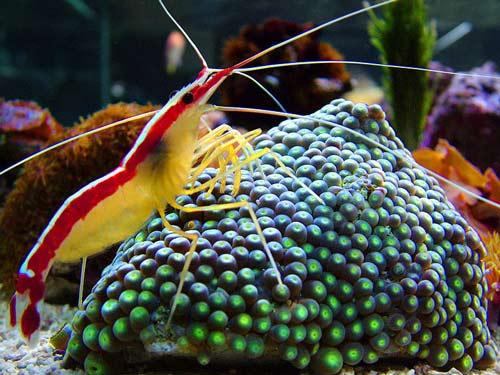Jacques, the Pacific cleaner shrimp

We have many of the fish from 'Finding Nemo' at the Aquarium, but the non-fish we have from the film is the Pacific cleaner shrimp ('Lysmata amboinensis'), which is the character Jacques.
We love invertebrates and this shrimp is in our top ten! In the film, Jacques has what looks like an impressive moustache. His 'moustache' is the real life shrimp's antennae. If you look closely at Jacques you’ll see he actually has two moustaches.
This is the same with shrimps. They have a long antennae (usually longer than their body length) which they use to touch, and to help orientate themselves with their surroundings. This is also used for 'tasting' and 'smelling' what’s around them. Their shorter antennae are used to assess whether their prey is suitable for eating.
Cleaner shrimp 'clean up' other animals in the sea. Cleaning stations have been observed, occupied by a few cleaner shrimp waiting for fish like eels and groupers to come by. Once they’ve got their 'customers' they will climb on board and start to pick away at any external parasites which the shrimp then eat. Some fish may even open their mouths to allow the shrimp inside! You might think that this was a trap and that the shrimp will be guzzled. It’s no trap though, because the fish have worked out that having parasites removed is much better for their health in the long run, than making a meal of the little shrimp. They also 'clean up' the algae in the tank.
In 'Finding Nemo', when they’re plotting to escape the tank, Jacques is ordered by the other fish to stop 'cleaning', which results in a very algaefied tank within a few days. In reality a shrimp will pick at algae, but they wouldn’t be able to keep all algae at bay. It grows too fast and would be far too much for one shrimp to deal with it all.
If you were to ask us if our cleaner shrimp was a girl or a boy, we'd have to tell you they’re both! All these shrimps are born male, and then along their lifespan develop female organs as well. This is known as 'protandric simultaneous hermaphroditism'. They are able to function as a male or female when it comes to their reproductive life.
Our cleaner shrimp are a bit shy - they hide in their tank so you need to look hard if you want to spot them. If we ever need to clean their tanks, sometimes we get a shock when they come up to clean us! They have little claws at the end of their legs which they use to pick off parasites on fishes and dead skin on humans. For small claws they’re surprisingly sharp, though I guess this is a must for retrieving stuck in parasites. It’s not really painful, but it certainly feels a bit odd!
